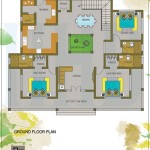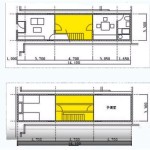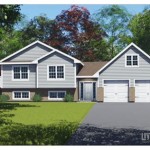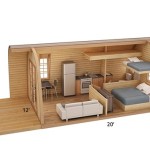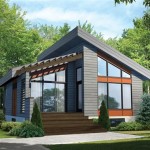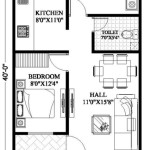Plan, Elevation, and Section of a Small House: A Comprehensive Guide
Planning and designing a small house requires careful consideration of multiple factors, including functionality, aesthetic appeal, and structural integrity. To ensure a successful project, architects and builders rely on a set of technical drawings that provide a comprehensive overview of the house's layout, dimensions, and construction details. These drawings consist of three primary types: plan, elevation, and section. Understanding their purpose and interpretation is crucial for both professionals and homeowners involved in the building process.
Plan View: A Bird's-Eye Perspective
The plan view, often referred to as the floor plan, offers a top-down perspective of the house as if it were sliced horizontally. This drawing shows the arrangement of rooms, walls, doors, windows, and other permanent fixtures. It presents a clear picture of the house's layout, highlighting the flow of spaces and the relationship between different areas. Essential information included in the plan view includes:
- Room Dimensions: Length and width of each room, providing accurate measurements for furniture placement and interior design.
- Wall Thickness: Displayed to understand the overall footprint of the house and its impact on usable space.
- Door and Window Placement: Indicating their size, type, and swing direction, influencing the flow of light and air within the house.
- Fixed Features: Placement of stairs, fireplaces, built-in shelves, and other permanent elements that impact the layout.
- Plumbing and Electrical Symbols: Indicating locations of outlets, fixtures, and essential infrastructure, guiding installation during construction.
The plan view is the foundation for visualizing the house's internal layout and ensuring efficient use of space. It serves as a blueprint for contractors and interior designers, providing them with the necessary information for construction and furnishing.
Elevation View: Capturing the Exterior Profile
The elevation view presents a side-on perspective of the house, showcasing its external appearance. Each elevation drawing depicts a specific side, such as the front, rear, or side elevations. These drawings provide a detailed representation of the house's exterior elements, including:
- Roofline: Detailed profile of the roof, including its shape, pitch, and materials.
- Wall Heights and Materials: Displaying the height of each wall and the materials used for construction, such as brick, stone, or wood.
- Window and Door Placement: Showcasing the size, shape, and style of windows and doors, influencing the overall aesthetic appeal.
- Exterior Features: Including porches, balconies, decks, and other architectural elements that define the house's character.
- Landscaping Details: Occasionally including basic landscaping elements such as trees, shrubs, and pathways for visual context.
The elevation views allow homeowners and builders to visualize the house's exterior from different angles, ensuring the design aligns with their aesthetic preferences. They are essential for understanding the house's overall shape and its interaction with the surrounding landscape.
Section View: A Cut Through the Structure
The section view offers a cross-sectional representation of the house, revealing its internal structure and the relationship between various components. Imagine slicing through the house with a vertical plane; the section view portrays the layout of walls, floors, ceilings, and other structural elements. Key elements depicted in the section view include:
- Wall Construction: The thickness, materials, and insulation of walls, providing insights into the house's thermal performance.
- Floor and Ceiling Heights: Revealing the vertical dimensions of the house and the visual impact of different floor levels.
- Staircase Layout: Showing the arrangement of stairs, landings, and handrails, ensuring safe and efficient movement between floors.
- Structural Elements: Including beams, columns, and other supporting structures that contribute to the house's stability.
- Roof Framing: Revealing the construction methods used for the roof, including the type of trusses or rafters supporting the roof structure.
The section view is vital for structural engineers and contractors to understand the house's construction methods and ensure its stability. It helps visualize the interplay of different structural components, optimizing the design for strength and practicality.

Small Residential House Detail Plan Elevation And Section Autocad File Floor Plans How To

Beautiful Small House Elevation Section And Plan Cad Drawing Details Jpg File Cadbull

Small House Left Right And Perspective Elevation With Ground Floor Plan Details Dwg File Simple Plans Open

Small Two Story House Elevation Section And Plan Cad Drawing Details Dwg File Cadbull

20 X 29 Single Bhk East Facing Small House Plan As Per Vastu Shastra Autocad Dra Design Plans Floor

Small Single Story House Elevation Section And Plan Drawing Details Dwg File Cadbull

1 Bhk Small House Plan And Sectional Elevation Design Dwg File 2bhk Floor One Plans

Small House Plan Elevation And Section Detail Dwg File Cadbull

House Plan Elevation Sectionautocad File Includes Two Y Elevatio Building Design Architectural Plans Small Architecture

Architectural Building Elevation Section And Plan Layout Dwg File

